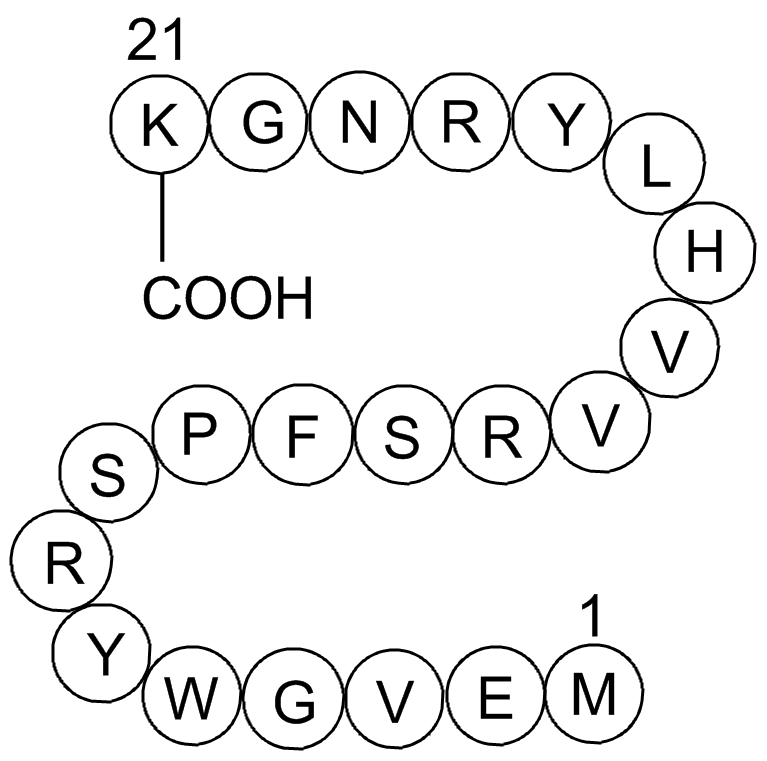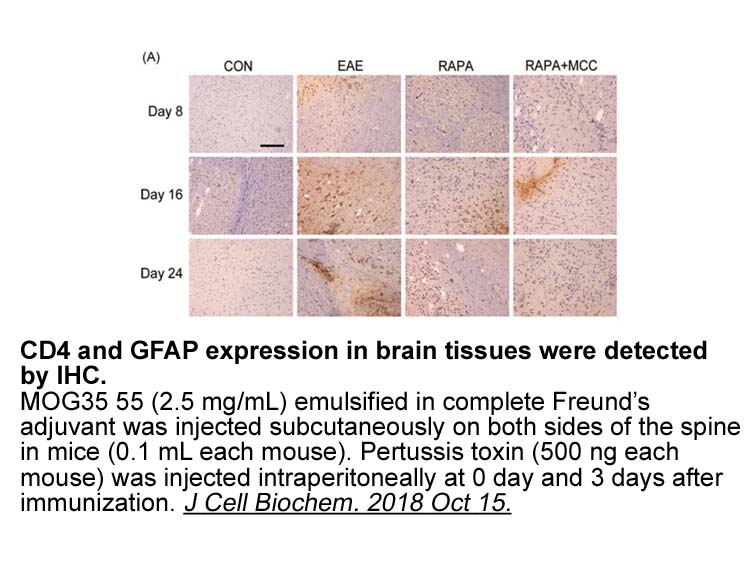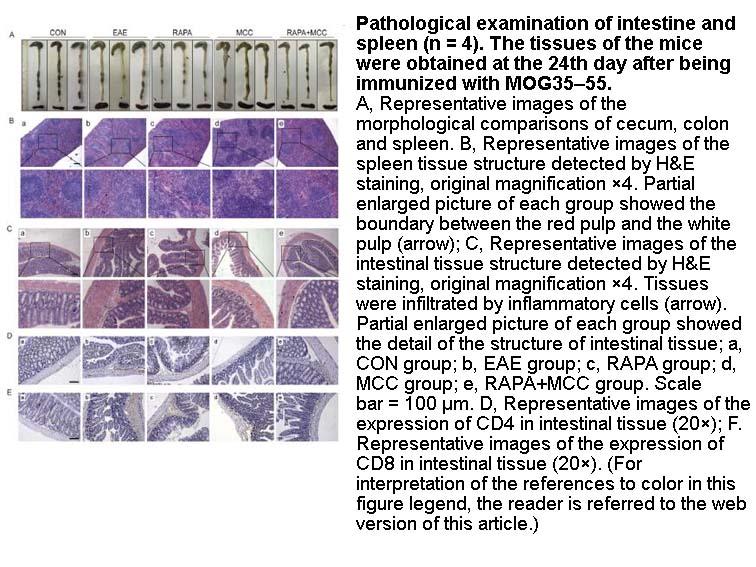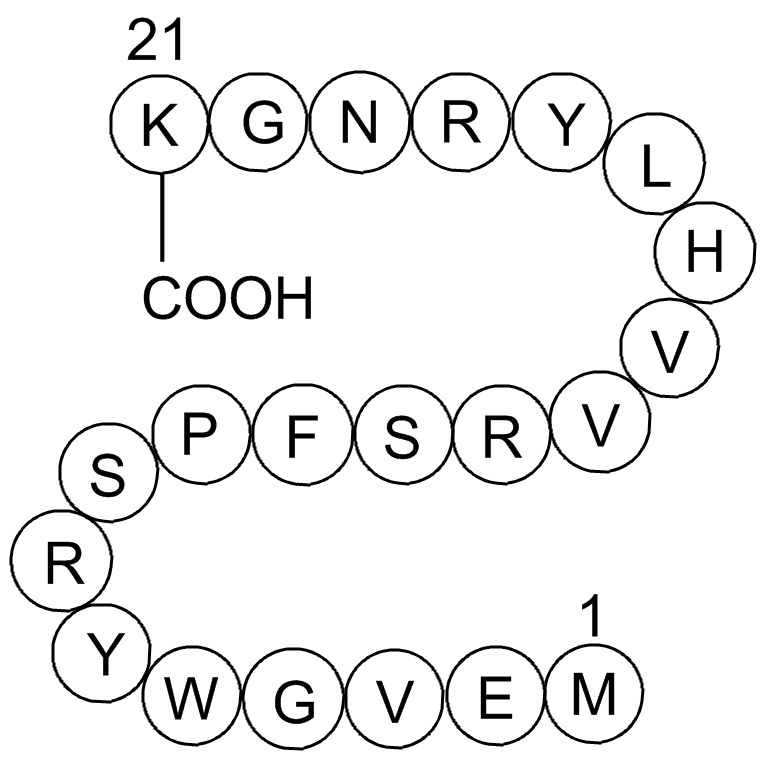MOG (35-55)
MOG (35-55) is a truncated peptide derived from the human Myelin Oligodendrocyte Glycoprotein (MOG). MOG, a member of the immunoglobulin superfamily, is expressed wildly in the central nervous system. In mouse and rat models for human multiple sclerosis, MOG is involved in inducing the experimental autoimmune encephalomyelitis. Humoral auto-immunity to the myelin oligodendrocyte glycoprotein (MOG) may be associated with the pathogenesis of multiple sclerosis (MS) [1].
MOG (35-55) is involved in inducing autoantibody production and relapsing-remitting neurological disease causing extensive plaque-like demyelination [2]. In HLA-DR2-transgenic mice, Myelin oligodendrocyte glycoprotein-35-55 peptide induced severe chronic experimental autoimmune encephalomyelitis [3].MOG35-55 was highly encephalitogenic and could induce strong T and B cell responses in rats [4]. In NOD/Lt mice (H-2g7) and C57BL/6 mice (H-2b), single injection of MOG35-55 in CFA could induce MS-like disease [4].
References:
[1]. De March A K, De Bouwerie M, Kolopp-Sarda M N, et al. Anti-myelin oligodendrocyte glycoprotein B-cell responses in multiple sclerosis[J]. Journal of neuroimmunology, 2003, 135(1): 117-125.
[2]. Slavin A, Ewing C, Liu J, et al. Induction of a multiple sclerosis-like disease in mice with an immunodominant epitope of myelin oligodendrocyte glycoprotein[J]. Autoimmunity, 1998, 28(2): 109-120.
[3]. Rich C, Link J M, Zamora A, et al. Myelin oligodendrocyte glycoprotein‐35–55 peptide induces severe chronic experimental autoimmune encephalomyelitis in HLA‐DR2‐transgenic mice[J]. European journal of immunology, 2004, 34(5): 1251-1261.
[4]. Slavin A, Ewing C, Liu J, et al. Induction of a multiple sclerosis-like disease in mice with an immunodominant epitope of myelin oligodendrocyte glycoprotein[J]. Autoimmunity, 1998, 28(2): 109-120.
- 1. Jiashu Xu, Tao Yu, Zongwei Yue. "PARP7 inhibition stabilizes STAT1/STAT2 and relieves experimental autoimmune encephalomyelitis in mice." Cell Rep. 2025 Aug 26;44(8):116130 PMID: 40811059
- 2. He Jingjing Wu Tongqian, Yan Shirong, et al. "S100A4 promotes experimental autoimmune encephalomyelitis by impacting microglial inflammation through TLR4/NF-κB signaling pathway." Int Immunopharmacol. 2024 Sep 5;142(Pt A):112849 PMID: 39241524
- 3. Ruihua Liu, Yan Li, et al. "OIP5-AS1 facilitates Th17 differentiation and EAE severity by targeting miR-140-5p to regulate RhoA/ROCK2 signaling pathway." Life Sci. 2021 Jan 27;119108 PMID: 33515560
- 4. Xu L, Zhang C, et al. "Rapamycin and MCC950 modified gut microbiota in experimental autoimmune encephalomyelitis mouse by brain gut axis." Life Sci. 2020;253:117747 PMID: 32376270
- 5. Xu L, Zhang C, et al. "Rapamycin combined with MCC950 to treat multiple sclerosis in experimental autoimmune encephalomyelitis." J Cell Biochem. 2018 Oct 15 PMID: 30320900
| Physical Appearance | A solid |
| Storage | Desiccate at -20°C |
| M.Wt | 2581.97 |
| Cas No. | 149635-73-4 |
| Formula | C118H177N35O29S |
| Solubility | ≥32.25 mg/mL in H2O; insoluble in EtOH; ≥86 mg/mL in DMSO |
| Chemical Name | (S)-2-((Z)-((2S,3R)-3-amino-1,2-dihydroxy-4-phenylbutylidene)amino)-4-methylpentanoic acid compound with 2,2,2-trifluoroacetic acid (1:1) |
| SDF | Download SDF |
| Canonical SMILES | CC(C)C[C@@H](C(O)=O)NC([C@H]([C@@H](Cc1ccccc1)N)O)=O.OC(C(F)(F)F)=O |
| Shipping Condition | Small Molecules with Blue Ice, Modified Nucleotides with Dry Ice. |
| General tips | We do not recommend long-term storage for the solution, please use it up soon. |
| Cell experiment [1]: | |
|
Cell lines |
Brain endothelial cells |
|
Preparation method |
The solubility of this compound in sterile water is 0.50 mg/mL. General tips for obtaining a higher concentration: Please warm the tube at 37 °C for 10 minutes and/or shake it in the ultrasonic bath for a while. Stock solution can be stored below - 20 °C for several months. |
|
Reacting condition |
0 ~ 50 μg/mL; 48 hrs |
|
Applications |
MOG (35-55) significantly decreased the protein concentration in a dose-dependent manner. In cells treated with MOG (35-55) (50 μg/mL) + CFA + PTX, the protein concentration decreased to 37.6% of the level in the CON cells. At the doses of 25 or 50 μg/mL, MOG (35-55) emulsion substantially increased the activities of NADPH oxidase and MMP-9 (44.1 ~ 48.5% and 2-fold higher than those in the CON cells, respectively). |
| Animal experiment [2]: | |
|
Animal models |
C57BL/6 mice |
|
Dosage form |
50, 100 or 150 μg; s.c. |
|
Applications |
At the doses of 50 and 100 μg, MOG (35-55) induced more dramatic weight losses during the course of the MS-like disease, when compared with mice injected with 150 μg MOG (35-55). At day 17 after treatment, 3/5 mice in the 50 μg MOG (35-55) group were moribund whereas 4/5 mice still survived in the 100 and 150 μg dose groups. However, no clinical sign and disease progression were observed in these 3 groups of mice. |
|
Other notes |
Please test the solubility of all compounds indoor, and the actual solubility may slightly differ with the theoretical value. This is caused by an experimental system error and it is normal. |
|
References: [1]. Seo JE, Hasan M, Rahaman KA, Kang MJ, Jung BH, Kwon OS. A leading role for NADPH oxidase in an in-vitro study of experimental autoimmune encephalomyelitis. Mol Immunol. 2016 Apr;72:19-27. [2]. Slavin A, Ewing C, Liu J, et al. Induction of a multiple sclerosis-like disease in mice with an immunodominant epitope of myelin oligodendrocyte glycoprotein[J]. Autoimmunity, 1998, 28(2): 109-120. |
|
Quality Control & MSDS
- View current batch:
Chemical structure

Related Biological Data

Related Biological Data









